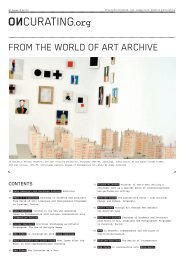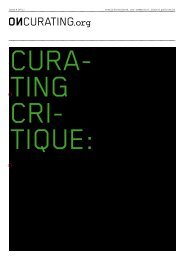You also want an ePaper? Increase the reach of your titles
YUMPU automatically turns print PDFs into web optimized ePapers that Google loves.
013 Issue # 11/11 : PublIc Issues<br />
Public <strong>as</strong> object<br />
A conceptual closing of the idea of the public produces the public <strong>as</strong> an object – for<br />
e<strong>as</strong>y consumption. In the above discussion, the planner produces the public <strong>as</strong> a homogenous<br />
m<strong>as</strong>s (of pedestrians and car drivers), with singular needs (of p<strong>as</strong>sing through).<br />
This public is an object – to be consumed to make plans. The production of the public<br />
<strong>as</strong> an object is best captured in the practices of public art.<br />
There is a recent surge in the art practices concerned with the public. There are typically<br />
three ways in which these practices work out. The first one is where the artist takes<br />
up the cause of the disadvantaged, the oppressed, and the exploited. The typical modus ope-<br />
randi is to bare the facts about the disadvantage, exploitation, and oppression, and<br />
to present it to the world in creative ways expecting the arousal of large-scale outrage<br />
against the advantage-takers, the exploiters, and the oppressors. In this c<strong>as</strong>e, the whole<br />
purpose of art is to make it useful for a cause. The second one is slightly different<br />
in its intentions – these are the practices that become f<strong>as</strong>cinated with material that is<br />
so to say unusual. The modes of operation in these practices include entering the depths<br />
of such material, knowing about it, and doing something with it. Here the question is<br />
not how art becomes useful to the cause but rather how the unusual material becomes useful<br />
to art. Various kinds of archiving practices are examples of this category of practice.<br />
However, the most vulgar form of this kind is the engagement with remote communities<br />
(tribes, for instance) and then work with them and bring their art to the city to be shown<br />
in the gallery space. The third are works that expect public engagement. These could be<br />
in form of objects installed within the gallery or outside in the city; or could even be<br />
performances and workshops involving the public. Intentions here include provoking the<br />
public, sensitizing it, or even simply expecting a response from unusual interventions in<br />
urban spaces.<br />
The interrogation of relationships between the artist, the art object, and the public c<strong>as</strong>t<br />
light on the problems of this kind of art. Various questions – Who is the public? What<br />
is the relationship of the artist with the public? What does such art do to the public?<br />
Does the public require such art? What happens when this art is sold? – emerge when such<br />
an interrogation is undertaken. Such questioning also reinforces the contention that the<br />
public is produced <strong>as</strong> an object in these kinds of works. The public is either represen-<br />
ted in the art, or engaged with it during the production process, or is expected to engage<br />
with the art <strong>as</strong> it is produced or after it h<strong>as</strong> been produced. The public, however, re-<br />
mains external to the artist and the art object. The art is either for, about, or by the<br />
public. The artist becomes a representative, interpreter, employer, or curator of the<br />
public, but seldom part of it. This externalization of the public turns it into an object<br />
to be consumed – by being represented, spoken about, employed, or curated. While these<br />
works claim to be public art, they end up producing the public <strong>as</strong> an object (fig. 2).<br />
Public <strong>as</strong> ethic<br />
The 1974 Bollywood blockbuster ROTI (directed by Manmohan Desai) contains a song on<br />
the idea of the public. Written by Anand Bakshi, the song is sung by Kishore Kumar<br />
and enacted by Rajesh Khanna. The opening lyrics, 'yeh jo public hai, ye sab jaanti hai,<br />
aji andar kya hai, aji bahar kya hai, ye sab kuchh pehchaanti hai' (This public, it is<br />
aware of everything, whatever is inside, whatever is outside, it recognizes everything),<br />
themselves bestow upon the idea of public an almost eternal all-knowing characterization.<br />
In the video, Rajesh Khannna walks along with a large crowd of people, but looks out of<br />
the screen talking to the audience and explaining the concept of the public. The song is<br />
shot at three locations – a street with a procession, a public meeting, and a park, clear-<br />
ly identifying with the popular understanding of the public. Along with the image and<br />
notions about the idea of the public, the song also encapsulates the power <strong>as</strong>sociated with<br />
it – namely, the power of encomp<strong>as</strong>sing knowledge about everything. The video of the song<br />
suggests the source of this power, which is the crowd. Rajesh Khanna acts simultaneously<br />
on behalf of the crowd and <strong>as</strong> a part of the crowd. Throughout the song he is involved<br />
in exposing many secrets of people. The suggestion that nothing escapes the many eyes of<br />
this crowd is amply (though simplistically) clarified. Here the public is produced <strong>as</strong> a<br />
watchdog, a guardian of truth, the bearer of knowledge, and a magnanimous whole above an<br />
individual. The individual is not only being watched by the public, but is also accountable<br />
and answerable to the public. The public here is produced <strong>as</strong> an ethic.<br />
The production of the public <strong>as</strong> an ethic could be best described through the activities<br />
of the media. The high-decibled and aggressive television anchors of Indian news channels<br />
are generally seen pushing the politician/bureaucrat by repeatedly stating, 'today the<br />
public wants an answer…'. Although annoyed, the politicians/bureaucrats offer defensive<br />
responses to explain their position. However, they never <strong>as</strong>k the question, 'Who are you<br />
to <strong>as</strong>k that question?' or 'Who is the public?' The public here is not only produced <strong>as</strong> a<br />
set of people, but more <strong>as</strong> an ethic that cannot be challenged. In another instance, a few<br />
years ago, the government banned women dancers from the bars of Mumbai, stating that they<br />
were creating an immoral condition in the city. A small group of people opposed the ban


![Download as PDF [10.6 MB]](https://img.yumpu.com/4266533/13/500x640/download-as-pdf-106-mb.jpg)

